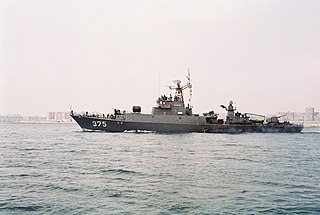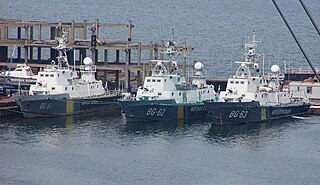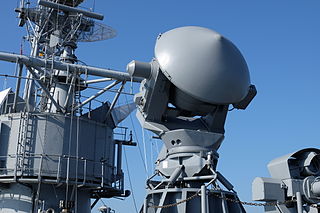
The Los Angeles class of submarines are nuclear-powered fast attack submarines (SSN) in service with the United States Navy. Also known as the 688 class after the hull number of lead vessel USS Los Angeles (SSN-688), 62 were built from 1972 to 1996, the latter 23 to an improved 688i standard. As of 2022, 26 of the Los Angeles class remain in commission—more than any other class in the world—and they account for more than half of the U.S. Navy's 50 fast attack submarines.

The AK-230 is a Soviet fully automatic naval twin 30 mm gun. Its primary function is anti-aircraft. It is mounted in an enclosed automatic turret and directed by radar. AK-230 is widely used, mounted on big warships as well as small craft. About 1450 guns were produced in the USSR, and about 300 were produced in China as the Type 69. It was succeeded by the more powerful AK-630 from the mid-to-late 1970s.

The Delhi-class destroyers are Semi-stealth guided-missile destroyers of the Indian Navy. Three ships of this class are in active service. The Delhi-class vessels were the largest vessels to be built in India at the time of their commissioning. The ships were built by Mazagon Dock Limited (MDL) at a cost of ₹750 crore each.

The Echo class were nuclear cruise missile submarines of the Soviet Navy built during the 1960s. Their Soviet designation was Project 659 for the first five vessels, and Project 675 for the following twenty-nine. Their NATO reporting names were Echo I and Echo II. All were decommissioned by 1994.

The AN/SPG-51 is an American tracking / illumination fire-control radar for RIM-24 Tartar and RIM-66 Standard missiles. It is used for target tracking and Surface-to-air missile guidance as part of the Mk. 73 gun and missile director system, which is part of the Tartar Guided Missile Fire Control System.

The Kh-25/Kh-25M is a family of Soviet lightweight air-to-ground missiles with a modular range of guidance systems and a range of 10 km. The anti-radar variant (Kh-25MP) is known to NATO as the AS-12 'Kegler' and has a range up to 40 km. Designed by Zvezda-Strela, the Kh-25 is derived from the laser-guided version of the Kh-23 Grom. The Kh-25 remains in widespread use despite the apparent development of a successor, the Kh-38.
The P-500 Bazalt is a turbojet-powered, supersonic cruise missile used by the Soviet and Russian navies. Its GRAU designation is 4K80 and its NATO reporting name is SS-N-12 Sandbox, its upgraded version being the P-1000 Vulkan AShM SLCM.

The Parchim-class corvette, Soviet designation Project 1331M, was developed for the East German Navy in the late 1970s, and built by the Wolgast Peene-Werft. The ships were designed for coastal anti-submarine warfare. In case of an all-out NATO-Warsaw Pact war in Europe their prime targets would have been the small U-206 coastal submarines of the West German navy. The first ship, Wismar, was launched on 9 April 1981 in Rostock, and subsequently another 15 ships were built until 1986. To make production more economical, the Soviet Union agreed to purchase another 12 ships from Wolgaster Peenewerft built between 1986 and 1990, thereby effectively subsidising the East German shipbuilding industry.

The Project 205 Moskit (mosquito) more commonly known by their NATO reporting name Osa, are a class of missile boats developed for the Soviet Navy in the late 1950s. Until 1962 this was classified as a large torpedo boat.

The Zvezda Kh-66 and Kh-23 Grom are a family of early Soviet tactical air-to-surface missiles with a range of 10 km. They were intended for use against small ground or naval targets. The Kh-66 was effectively a heavy-warhead, beam-riding version of the K-8 air-to-air missile rushed into service in Vietnam in 1968. The Kh-23 was an improved Kh-66 with command-guidance, similar to the AGM-12 Bullpup.

The Kh-28 was the first Soviet anti-radiation missile for tactical aircraft. It entered production in 1973 and is still carried on some Sukhoi Su-22s in developing countries but is no longer in Russian service. Use of the Kh-28 was restricted by its weight, limited seeker head, bulk and fuelling requirements, and it was superseded by the smaller, solid-fuel Kh-58 in the early 1980s.

The RIM-66 Standard MR (SM-1MR/SM-2MR) is a medium-range surface-to-air missile (SAM), with a secondary role as an anti-ship missile, developed for the United States Navy (USN). A member of the Standard Missile family of weapons, the SM-1 was developed as a replacement for the RIM-2 Terrier and RIM-24 Tartar that were deployed in the 1950s on a variety of USN ships. The RIM-67 Standard (SM-1ER/SM-2ER) is an extended range version of this missile with a solid rocket booster stage.

The Stenka class is the NATO reporting name for a class of patrol boats built for the Soviet Navy and Soviet Allies. The Soviet designation was Project 205P Tarantul. The boats are an anti-submarine (ASW) patrol boat version of the Osa-class missile boat.

The Shershen class was the NATO reporting name for a class of torpedo boats built for the Soviet Navy and allies. The Soviet designation was Project 206 Shtorm.
The Neptune class was a proposed class of cruisers planned for the British Royal Navy in the latter years of the Second World War. They were large ships which were to be armed with twelve 6-inch (152 mm) dual-purpose guns and with a heavy secondary armament. Although five ships of the class were planned in 1944, they were cancelled following the end of the war and before construction could begin.

STIR is a medium-to-long range fire-control radar system manufactured by Thales Group. It is used for electro-optical tracking and missile illumination.

Gromkiy was a Project 1135M Burevestnik-class Guard Ship or 'Krivak II'-class frigate that served with the Soviet and Russian Navies. Launched on 11 April 1978, the vessel operated as part of the Northern Fleet as an anti-submarine vessel, with an armament built around the URPK-5 Rastrub missile system. In 1991, the ship took part in the semicentennial commemoration of the first of the arctic convoys of the Second World War alongside the Royal Navy frigate HMS London. Soon afterwards, the ship was transferred to the Russian Navy following the dissolution of the Soviet Union. Gromkiy served for less than two years in this new role before being withdrawn for repairs and, ultimately, decommissioning on 16 March 1998.

Mark 56 Gun Fire Control System is a gun fire-control system made up of AN/SPG-35 radar tracker and the Mark 42 ballistic computer.

Bessmennyy was a Project 1135M Burevestnik-class Guard Ship or 'Krivak II'-class frigate that served with the Soviet and Russian Navies. The vessel was the seventh of the class to enter service. Launched on 17 September 1977, Bessmennyy was designed to operate as an anti-submarine vessel with the Northern Fleet, using an armament built around the Metel Anti-Ship Complex. Following the dissolution of the Soviet Union, in 1991, the ship was transferred to the Russian Navy and took part in a pioneering visit to Gibraltar two years later, the first time that Russian warships had visited the territory in living memory. Bessmennyy was retired on 16 March 1998, disarmed and subsequently broken up.














